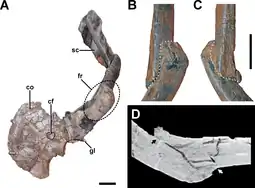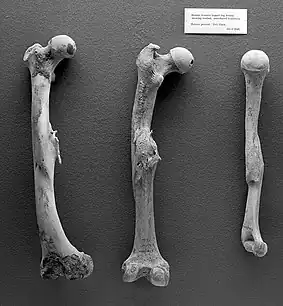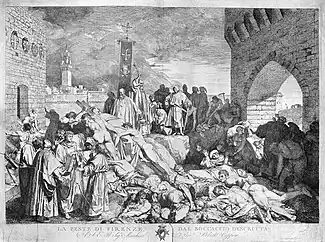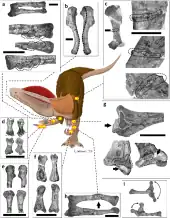Paleopathology

Paleopathology, also spelled palaeopathology, is the study of ancient diseases and injuries in organisms through the examination of fossils, mummified tissue, skeletal remains, and analysis of coprolites. Specific sources in the study of ancient human diseases may include early documents, illustrations from early books, painting and sculpture from the past. Looking at the individual roots of the word "Paleopathology" can give a basic definition of what it encompasses. "Paleo-" refers to "ancient, early, prehistoric, primitive, fossil." The suffix "-pathology" comes from the Latin pathologia meaning "study of disease."[1] Through the analysis of the aforementioned things, information on the evolution of diseases as well as how past civilizations treated conditions are both valuable byproducts. Studies have historically focused on humans, but there is no evidence that humans are more prone to pathologies than any other animal.[2]
Paleopathology is an interdisciplinary science, meaning it involves knowledge from many sectors including (but not limited to) "clinical pathology, human osteology, epidemiology, social anthropology, and archaeology".[3] It is unlikely that one person can be fluent in all necessary sciences. Therefore, those trained in each are important and make up a collective study. Training in Anthropology/archaeology are arguably most important because the analysis of human remains and ancient artifacts are paramount to the discovery of early disease.
History
Historical evidence shows that deviations from good health have long been an interest to humans. Although the content that makes up this study can be traced through ancient texts, the term "paelopathology" did not have much traction until the 20th century. This time period saw an increase in case studies and "published reports on ancient diseases".[4] Ancient texts that are thousands of years old record instances of diseases such as leprosy.
From the Renaissance to the mid-nineteenth century, there was increasing reference to ancient disease, initially within prehistoric animals although later the importance of studying the antiquity of human disease began to be emphasized. Some historians and anthropologists theorize that "Johann Friederich Esper, a German naturalist...heralds the birth of paleopathology."[5] Although it wasn't until between the mid nineteenth century and World War I that the field of human paleopathology is generally considered to have come about. During this period, a number of pioneering physicians and anthropologists, such as Marc Armand Ruffer, G. Elliot Smith, Frederic Wood Jones, Douglas E. Derry, and Samuel George Shattock, clarified the medical nature of ancient skeletal pathologies.[6] This work was consolidated between the world wars with methods such as radiology, histology and serology being applied more frequently, improving diagnosis and accuracy with the introduction of statistical analysis. It was at this point that paleopathology can truly be considered to have become a scientific discipline.[7] Today, the use of biomedical technology like DNA and isotopic analysis are major developments for pathological knowledge.[8]
After World War II paleopathology began to be viewed in a different way: as an important tool for the understanding of past populations, and it was at this stage that the discipline began to be related to epidemiology and demography.
New techniques in molecular biology also began to add new information to what was already known about ancient disease,[7] as it became possible to retrieve DNA from samples that were centuries or millennia old.
Methods and techniques
To analyze human remains of the past, different techniques are used depending on the type of remains that are found. For example, "the approach to palaeopathological samples depends on the nature of the sample itself (e.g. bone, soft tissue or hair), its size (from minimal fragments to full bodies), the degree of preservation and, very importantly, the manipulation allowed (from intact sample ready for display to absolute access and freedom to undertake any kind of valuable destructive analysis including a full autopsy study)."[9] Much research done by archaeologists and paleopathologists is on bones. The basic nature of bones allows them to not degrade over time like other human remains would, making osteopathology important in studying ancient disease. Human osteopathology is classified into several general groups:
Whilst traumatic injuries such as broken and malformed bones can be easy to spot, evidence of other conditions, for example infectious diseases such as tuberculosis and syphilis, can also be found in bones. Arthropathies, that is joint diseases such as osteoarthritis and gout, are also not uncommon.

The first exhaustive reference of human paleopathology evidence in skeletal tissue was published in 1976 by Ortner & Putschar.[10] In identifying pathologies, physical anthropologists rely heavily on good archaeological documentation regarding location, age of site and other environmental factors. These provide the foundation on which further analysis is built and are required for accurate populations studies. From there, the paleopathology researcher determines a number of key biological indicators on the specimen including age and sex. These provide a foundation for further analysis of bone material and evaluation of lesions or other anomalies identified.
Archaeologists increasingly use paleopathology as an important main tool for understanding the lives of ancient peoples. For example, cranial deformation is evident in the skulls of the Maya, where a straight line between nose and forehead may have been preferred over an angle or slope. There is also evidence for trepanation, or drilling holes in the cranium, either singly or several times in a single individual. Partially or completely healed trepanations indicate that this procedure was often survived. The 10,000 year-old human remains discovered at the site of Nataruk in Turkana, Kenya, reportedly show extreme traumatic lesions to the head, neck, ribs, knees and hands, including embedded stone projectiles, and they may represent the earliest evidence of inter-group conflict between hunter-gatherers in the past.[11][12]
Archaeological infectious diseases
Several diseases are present in the archaeological record. Through archaeological evaluation these diseases can be identified and sometimes can explain the cause of death for certain individuals. Aside from looking at sex, age, etc. of a skeleton, a paleopathologist may analyze the condition of the bones to determine what sort of diseases the individual may have. The goal of a forensic anthropologist looking at the Paleopathology of certain diseases is to determine if the disease they are researching are still present over time, with the occurrence of certain events, or if this disease still exists today and why this disease may not exist today.[13] Some disease that are found based on changes in bone include
Apart from bones, molecular biology has also been used as a tool of paleopathology over the last few decades, as DNA can be recovered from human remains that are hundreds of years old. Since techniques such as PCR are highly sensitive to contamination, meticulous laboratory set-ups and protocols such as "suicide" PCR are necessary to ensure that false positive results from other materials in the laboratory do not occur.
For example, the long-held assumption that bubonic plague was the cause of the Justinian plague and the Black Death has been strongly supported by finding Yersinia pestis DNA in mass graves,[14][15] whereas another proposed cause, anthrax, was not found.[14]

Black Death
The Black Death pandemic occurred between 1347 and 1351.[16] It is believed that the origin of the Black Death was bubonic plague.[16] Symptoms of Bubonic Plague include swollen lymph nodes, fever, headache, fatigue, and muscle aches.[17] Some people also developed swellings in which blood and pus seeped from them during the Black Death.[18] The Black Death originated in China and spread along trade routes and ports affecting many countries including North Africa and many European countries such as Italy, Spain, France, Germany, Switzerland, and Hungary.[16] It is estimated that the Black Death killed up to 200 million people.[19]
In 2013, during an excavation in Thornton Abbey in North Lincolnshire, a mass grave was discovered with 48 people in it including 27 children.[20] Radiocarbon dating and artifacts found in the mass grave allowed archaeologists to narrow down the time period in which the bodies were from to the time of the Black Death.[20] The wide range of ages of the remains, from one to 45 years of age, led archaeologists to determine that something devastating most likely caused their deaths.[20] Typically, mass graves contain remains from either very young ages or very old ages: this was not the case here. Because all ages were being buried here, archaeologists could deduce that although Lincolnshire is a small town, it was consumed by the plague to the extent in which a mass grave was needed. A mass grave was up until this discovery, very rare because small towns seemed to bury their dead in usual ways.[21] It is believed that the reason for mass burials in Europe during this time were because of the overwhelming number of deaths caused by the Black Plague.[19]
Archaeologists extracted teeth samples from the remains of the individuals who were buried, and it was revealed that there was the presence of plague bacteria.[20] These samples showed the presence of Y. pestis DNA, the bacterial cause of the plague. "Molecular identification by 'suicide PCR' of Yersinia pestis in the pulp tissue of teeth" and other forms of analysis on ancient DNA has become progressively more common with modern advancements.[22]
Tuberculosis
Some diseases are difficult to evaluate in the archaeology, however, tuberculosis can be found and dates as far back as the Neolithic period. Tuberculosis is presumed to have been transmitted from domesticated cattle to humans through ingestion of contaminated meats and the drinking of contaminated milk.[23] It is also possible to contract tuberculosis through contact with infected persons. When an infected person coughs, they eject infected mucus from their body which can possibly infect those close by.[24] There are several types of tuberculosis: the kind that affects cold-blooded animals, the kind that affects birds, and the bovine type that causes disease in humans. Because bovine tuberculosis is often found in children, it may be that the disease is spread through the consumption of contaminated milk.[25]
Tuberculosis manifests itself in the archaeological record through DNA extraction from the skeletal remains of people. Tuberculosis rarely manifests itself in the skeleton of individuals and when it does, it is usually only in advanced stages of the disease.[26] The tuberculosis bacteria stays in the growth centers and spongy areas of the bone.[25] This disease has a very long period of maturation, or the time it takes the disease to reach its full destructive potential. Because of the long period of development in the body, tuberculosis damages the body and then the body has time to repair itself. The evidence of the disease in bones can be seen in the destruction and healing of the bone structures especially in joints. Tuberculosis therefore appears in the archaeology record in the knee and hip joints and also the spine.[24]
It was thought that there was no tuberculosis infection in North America before the arrival of Europeans, but recent findings from the 80s and 90s have overturned that idea.[27] Through extraction of DNA within the bone tuberculosis was not only found, but also dated to have been present in the Americas since 800 BC. Tuberculosis is a disease that thrives in dense populations. So the implications of finding tuberculosis in pre-Columbian society indicates that there was a large thriving community at the time.[28] The earliest evidence of tuberculosis has been found in Italy dating to the 4th millennium BC. Evidence of tuberculosis has also been found in mummies from ancient Egypt dating to the same period. There is however, a lack of medical texts from ancient European and Mediterranean regions describing diseases that are identifiable as Tuberculosis but the bones show that there was a disease of this type.[29]
Syphilis
Syphilis is a disease classified in a category of Treponemal disease. This group includes diseases like pinta, yaws, endemic syphilis and venereal syphilis. These diseases have symptoms that include inflammatory changes in tissues throughout the body. Initially the infected person may notice an area of inflammation at the site where the bacteria entered the body. Then the individual can expect more widespread soft tissue changes and lastly the diseases start to affect the bones. However, Only 10-20 percent of people infected with venereal syphilis show bone changes.[30] Venereal syphilis has more severe symptoms than the other types of treponemal disease. Nervous system and circulatory disruption are unique to venereal syphilis and are not seen in yaws, endemic syphilis or pinta.
Bone changes can be seen in the archaeological record through lesions on the surface on the bone. In venereal syphilis the bone change is characterized by damage to the knees and joints. The damaged joints could be the source of infection or they could be damaged because of disruption in the nervous systems and ability to feel.[31] In the beginning stages of the disease, the bone forms small lesions on the skull and tibiae. These lesions are caused mostly by inflammation of the marrow. In the final stages of the disease the bones start to be destroyed. Lesions that are formed tend to look similar to "worm holes" in the bone and are seen in the skull as well as large bones in the body.[25] Most of the bone that is destroyed is due to secondary infections.
Syphilis has been seen in the Americas and Europe alike but there is debate as to what the origin of the disease is. Columbus and his sailors were said to have brought it to the Americas, however, Europeans blame Columbus for bringing the disease to Europe. There has not been any evidence of bone lesions associated with the disease that Columbus and the Europeans describe.[32] The debate on the origins of venereal syphilis has been the subject of scientific discussions for hundreds of years and has recently been discussed and debated. At the first International Congress on the Evolution and Paleoepidemiology the subject was examined and debated by scholars from all over the world. There was no conclusive decision made as to the origin of venereal syphilis.

See also
- Egg paleopathology
- Retrospective diagnosis
Footnotes
- ↑ Ortner, Donald J (2003). Identification of Pathological Conditions in Human Skeletal Remains. Elsevier. ISBN 978-0-12-528628-2.
- ↑ Hogenboom, Melissa (31 October 2015). "The animal that doesn't get cancer". BBC-Earth. BBC. Retrieved 24 August 2016.
- ↑ Snoddy, Anne Marie E.; Beaumont, Julia; Buckley, Hallie R.; Colombo, Antony; Halcrow, Siân E.; Kinaston, Rebecca L.; Vlok, Melandri (2020-03-01). "Sensationalism and speaking to the public: Scientific rigour and interdisciplinary collaborations in palaeopathology". International Journal of Paleopathology. 28: 88–91. doi:10.1016/j.ijpp.2020.01.003. hdl:10454/17640. ISSN 1879-9817. PMID 32028057.
- ↑ Buikstra, Jane E.; DeWitte, Sharon (2019-01-01), Buikstra, Jane E. (ed.), "Chapter 2 - A Brief History and 21st Century Challenges", Ortner's Identification of Pathological Conditions in Human Skeletal Remains (Third Edition), San Diego: Academic Press, pp. 11–19, doi:10.1016/b978-0-12-809738-0.00002-8, ISBN 978-0-12-809738-0, retrieved 2020-10-04
- ↑ Grauer, Anne L. (2018). "A century of paleopathology". American Journal of Physical Anthropology. 165 (4): 904–914. doi:10.1002/ajpa.23366. ISSN 1096-8644. PMID 29574849.
- ↑ Buikstra, Jane; Roberts, Charlotte, eds. (2012). The Global History of Paleopathology: Pioneers and Prospects. Oxford University Press. p. 212. ISBN 9780195389807.
- 1 2 Aufderheide, A.C and Rodríguez-Martín, C. 1998. The Cambridge Encyclopedia of Human Paleopathology. Cambridge: Cambridge University Press.
- ↑ Ortner, Donald J. (1991). Human Paleopathology: Current Syntheses and Future Options. Smithsonian Institution. ISBN 1-56098-039-7.
- ↑ Fernández, Pedro L. (2012). "Palaeopathology: The Study of Disease in the Past". Pathobiology. 79 (5): 221–227. doi:10.1159/000335165. ISSN 1015-2008. PMID 22722561.
- ↑ Ortner, Donald J. and Walter G. J. Putschar. 1981. Identification of Pathological Conditions in Human Skeletal Remains. Washington: Smithsonian Institution Press.
- ↑ Lahr, M. Mirazón; Rivera, F.; Power, R. K.; Mounier, A.; Copsey, B.; Crivellaro, F.; Edung, J. E.; Fernandez, J. M. Maillo; Kiarie, C. (2016). "Inter-group violence among early Holocene hunter-gatherers of West Turkana, Kenya". Nature. 529 (7586): 394–398. Bibcode:2016Natur.529..394L. doi:10.1038/nature16477. PMID 26791728. S2CID 4462435.
- ↑ Stojanowski, Christopher M.; Seidel, Andrew C.; Fulginiti, Laura C.; Johnson, Kent M.; Buikstra, Jane E. (2016). "Contesting the massacre at Nataruk". Nature. 539 (7630): E8–E10. doi:10.1038/nature19778. PMID 27882979. S2CID 205250945.
- ↑ Janssens 1970, pg 2
- 1 2 Raoult, D; Aboudharam G; Crubézy E; Larrouy G; Ludes B; Drancourt M (2000-11-07). "Molecular identification by "suicide PCR" of Yersinia pestis as the agent of medieval black death". Proc Natl Acad Sci U S A. 97 (23): 12800–3. Bibcode:2000PNAS...9712800R. doi:10.1073/pnas.220225197. PMC 18844. PMID 11058154.
- ↑ Drancourt, M; Roux V; Dang LV; Tran-Hung L; Castex D; Chenal-Francisque V; Ogata H; Fournier PE; Crubézy E; Raoult D (September 2004). "Genotyping, Orientalis-like Yersinia pestis, and plague pandemics". Emerg Infect Dis. 10 (9): 1585–92. doi:10.3201/eid1009.030933. PMC 3320270. PMID 15498160.
- 1 2 3 "Black Death | Definition, Cause, Symptoms, Effects, Death Toll, & Facts". Encyclopedia Britannica. Retrieved 2020-08-01.
- ↑ "Plague - Symptoms and causes". Mayo Clinic. Retrieved 2020-08-01.
- ↑ "Black Death". HISTORY. Retrieved 2020-08-01.
- 1 2 "Black Death mass grave discovered at 14th-century monastery hospital". phys.org. Retrieved 2020-08-01.
- 1 2 3 4 Katz, Brigit. "Mass Grave Shows the Black Death's 'Catastrophic' Impact in Rural England". Smithsonian Magazine. Retrieved 2020-08-01.
- ↑ "Medieval Black Death burial site found in Lincolnshire uproots previous theories held about the plague". The Independent. 2020-02-19. Retrieved 2020-11-28.
- ↑ Antoine, Daniel (2008). "5 The Archaeology of "Plague"". Medical History. Supplement (27): 101–114. ISSN 0950-5571. PMC 2632866. PMID 18575084.
- ↑ Roberts 1995
- 1 2 Roberts 1995, pg 137
- 1 2 3 Janssens 1970
- ↑ Buikstra 2006, pg. 310 and 364
- ↑ Buikstra 2006, pg 307
- ↑ Roberts 1995, pg. 141
- ↑ Roberts 1995, pg. 139
- ↑ Roberts 1995, pgs 151-155
- ↑ Roberts 1995, pg 153
- ↑ Janssens 1970, pg 104
References
- Buikstra, Jane E.; Lane A. Beck (2006). Bioarchaeology: The Contextual Analysis of Human Remains. Amsterdam: Academic Press.
- Janssens, Paul A. (1970). Paleopathology: Diseases and Injuries of Prehistoric Man. USA: Humanities Press Inc.
- Roberts, Charlotte; Keith Manchester (1995). The Archaeology of Disease. USA: Cornell University Press.
- Cohen, Mark Nathan; George J. Armelagos (1984). Paleopathology at the Origins of Agriculture. Orlando, Fl: Academic Press Inc.
External links
- Animal Palaeopathology Working Group (ICAZ)
- Paleopathology Association
- Samples of paleopathology publications
- A French site devoted to pathography, i.e. paleopathology of famous historical figures
- Paleopatologia.it - Official website of the University of Pisa, Italy. Directed by Gino Fornaciari
- The International Journal of Dental Anthropology - IJDA
- The Journal of Paleopathology
- Mueller, Tom (July–August 2013). "CSI: Italian Renaissance". Smithsonian. Retrieved 2013-07-21.